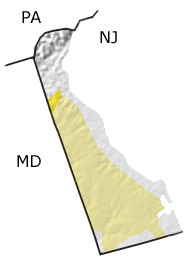Paleontology and geologyThe sea advanced and retreated several times over Delaware during the Tertiary, with most of the Coastal Plain covered by seawater during the early part of the period. Microscopic fossils of foraminifera and pollen, recovered from holes drilled into Early Tertiary sediments, indicate that these sediments were deposited mainly in deeper-shelf environments. The later Tertiary was characterized by an overall slow retreat of the sea. Alternation between sandy nearshore sediments and muddy offshore sediments across central and southern Delaware tell us that sea level fall was not steady; marine waters occasionally rose again for short intervals of time. Diverse fossil types are known from Late Tertiary-age (Miocene) localities, including the remains of ancient relatives of horses, rhinoceroses, porpoises, whales, seals, manatees, bats, beavers, dogs, birds, snakes, fish, snails, and bivalved molluscs. |

